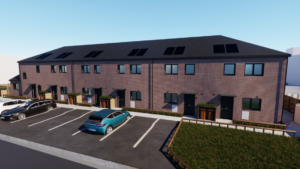Language, homes and logic. Part Two.
 In part one, I argued that changing the language used to describe the housing situation in the UK is a logical prerequisite for developing appropriate, sustainable solutions to the housing crisis.
In part one, I argued that changing the language used to describe the housing situation in the UK is a logical prerequisite for developing appropriate, sustainable solutions to the housing crisis.
A further critical point is a symbiosis between economic growth and access to homes. For the economy and communities to function effectively it is fundamental that working households can access homes close to their work and the social infrastructure. Where there is a gross mismatch the consequences can be seen as in the stews and rookeries of Victorian cities, the favelas of South America and beds in sheds across London today.
The goal of delivering additional homes is simple. You need land, materials and a skilled workforce. But each of these is often held back with caveats, constraints and conditions. There is a ritualistic denigration of planning and the continuing search for reform that will unlock the entrepreneurial spirit of housebuilders.
As a nation, we need to build more homes, but any changes in the way access to housing is controlled will impact on the number of new homes needed. I argued that when applying classical economic theory, the language that is currently used is not appropriate to describe and understand the housing issues in the UK.
Instead, we need to look at all the drivers affecting the demand for homes and determine what interventions are possible, practical and sustainable.
For families, one key driver is access to good quality schools. House prices spike in areas where children can go to highly rated schools and the scope to build more homes in such neighbourhoods can be limited with existing residents unwilling to move away from their social networks unless the price is right.
Without effective tools to capture some of that increase in price for the public purse, the opportunity to invest in new school places is limited, whilst adding school places in other neighbourhoods may reduce the pressure on prices. Another consideration may be how to encourage households without school-age children to move to other neighbourhoods. This approach leads to a series of coordinated interventions that impact on the availability of homes.
The Brexit conundrum
Since the Brexit referendum, the pound has weakened against other currencies. This means that the materials we import to build homes have become more expensive. There has been an upward pressure on costs which is driving up the costs of homes.
At the same time, labour costs are rising faster than in other sectors, despite a growing skills shortage. This shortage in construction skills is a longstanding problem and one that was alleviated by construction workers from Europe coming to the UK.
Like all issues with housing, there are no quick fixes. There are encouraging signs that investment in construction skills is coming, along with efforts to raise the profile of the wider construction sector as providing well paid and satisfying careers. This will take time to deliver results.
An alternative approach could be to change the mix of materials and skills needed to build homes. An initiative such as the GLA’s Precision Manufactured Homes programme to promote the use of off-site/factory based techniques to build homes can change the mix of skills and materials needed.
A consequence of using such construction methods is that homes are lighter. This means that it is possible to consider rooftops as the location for homes or sites which may not have been suitable for masonry construction due to their bearing capacity. Homes are built more quickly, reducing the disruption to neighbours and reducing the funding costs as homes produce income between 6 and 9 months sooner than a comparable traditionally built development.
A further challenge is extending the life of existing homes or converting existing redundant buildings to housing. Too many existing homes are small, cramped and dark. But imaginative reuse could provide a new, limited, life. This could be facilitated by a change to the VAT rules, which add between 5% and 20% to cost of improvements to homes.
Even with all these approaches, there will be a need to increase the amount of land used for homes. Currently, 9% of the UK is built on. There is a great deal that can be done by making existing neighbourhoods denser, enabling existing homeowners to build a new property in their garden and sell the larger property when vacated.
Increasing the height of developments at transport nodes is another option. But still more homes will be needed in rural areas to support the local economy, the Cambridgeshire and Peterborough Combined Authority is supporting the Community Land Trusts to bring forward developments in smaller settlements.
Listing all the possible initiatives and policy changes would be tedious and almost certainly some great ideas would be missed.
The scale of the challenge we face is immense. One result of the current situation is a spiralling bill for housing benefit which currently stands at£25Bn with £10.8Bn going to private landlords.
Using this money to fund an increase in sub-market housing across the country would represent good value to the taxpayer by funding assets which grow in value of over time. There will be a short-term cost as the delivery of new homes will take time until the increase in the benefits bill can be slowed, halted then possibly even reversed. A systems approach would also say that spending on wages and encouraging people to get the skills for building homes is positive.
There is a need for a national drive to build homes similar to the 40’s and 50’s, but alongside a commitment to give councils the ability to build there is a need to look at what works within a framework that benefits everyone.















